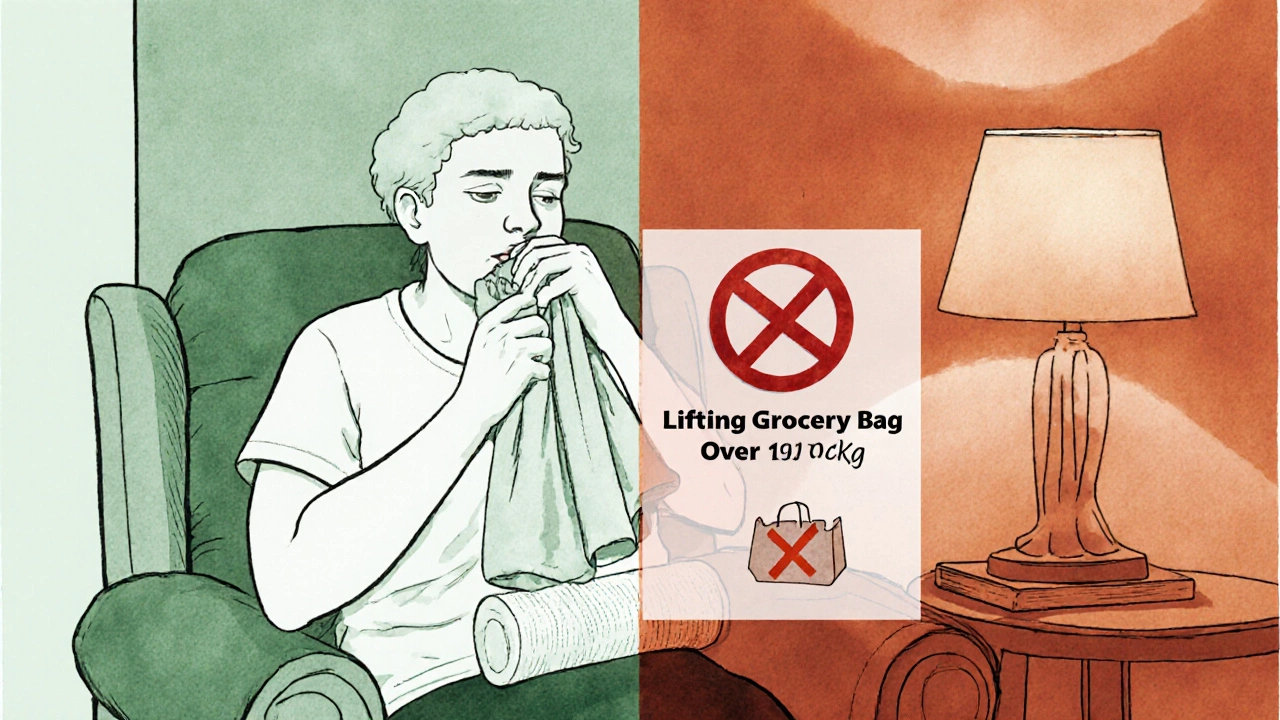- Home
- Cardiology
- Heart Surgery Restrictions: What You Can't Do After Surgery

Heart Surgery Restrictions: What You Can't Do After Surgery
Heart Surgery Recovery Timeline Calculator
Calculate Your Safe Recovery Timeline
Recovery Timeline
Activity Restrictions
Heart surgery is a major operation that repairs or replaces damaged parts of the heart. Whether you had a coronary artery bypass grafting (CABG), a valve replacement, or a less invasive procedure, the body needs time to heal before you resume normal life. Ignoring the recovery rules can lead to wound problems, blood clots, or even life‑threatening complications. Below is a practical guide that tells you exactly what you should avoid and why, plus a clear timeline to get you back on track safely.
Why Post‑Surgery Restrictions Matter
After any cardiac operation the sternum (breastbone) is wired together, and internal grafts or prosthetic valves need time to settle. The first few weeks are the most vulnerable period - the incision is still closing, inflammation is high, and anticoagulant medication may be in your system. Pushing the body too hard can cause the sternum to shift, bleeding to restart, or a graft to fail.
Typical Recovery Timeline
- Days 1‑7: Hospital stay or early home recovery. Focus on pain control, breathing exercises, and short, frequent walks.
- Weeks 2‑6: Most patients start light activities and attend Cardiac rehabilitation sessions. Sternal precautions are still strict.
- Weeks 6‑12: Gradual increase in aerobic exercise, return to light household chores, and possibly resume a desk job if approved.
- Months 3‑6: Many patients can engage in moderate‑intensity activities, drive, and travel, but heavy lifting and high‑impact sports usually remain off‑limits until the surgeon signs off.
Activities You Should Avoid
Below is a checklist of the most common “don’t‑do” items, paired with the typical waiting period before it becomes safe.
| Activity | Why It’s Restricted | Typical Safe Window |
|---|---|---|
| Heavy lifting & pushing >10 kg | Stress on the sternum can pull the wires apart. | 6‑8 weeks |
| Strenuous aerobic exercise (running, HIIT) | Elevated heart rate raises blood pressure, risking graft disruption. | 8‑12 weeks (after cardiac rehab clearance) |
| Driving | Pain or limited shoulder motion may impede safe control. | 2‑4 weeks (if off pain meds and you can perform a quick stop test) |
| Sexual activity | Early exertion can spike blood pressure. | 4‑6 weeks (most doctors say it’s fine once you’re comfortable walking briskly) |
| Sauna, hot tubs, and heated pools | Heat dilates blood vessels, lowering blood pressure and increasing bleeding risk. | 8‑12 weeks |
| Air travel (cabin pressure changes) | Can affect anticoagulation levels and wound healing. | 2‑4 weeks for short flights; longer trips may need doctor’s note. |
| High‑impact sports (basketball, soccer, martial arts) | Sudden collisions risk sternal fracture. | 6‑12 months (depends on surgeon’s assessment) |
| Pregnancy (for female patients) | Hormonal changes increase cardiac workload. | 12‑18 months post‑operation; always consult cardiologist. |

Sternal Precautions Explained
During the first 6‑8 weeks the sternum is held together by steel wires. Surgeons ask patients to follow "sternal precautions" which usually mean:
- Never raise both arms above shoulder level simultaneously.
- Avoid pushing up from a chair or getting up from a low surface using your arms.
- Keep your elbows close to your body when reaching forward.
- Use a pillow or rolled towel to support the incision when coughing.
These rules reduce the chance of the wires pulling apart and causing a painful sternal dehiscence.
Medication‑Related Restrictions
Most heart surgery patients are placed on anticoagulant therapy (e.g., warfarin, apixaban) to prevent clots. Anticoagulants interact with many activities:
- Contact sports: Even a minor hit can cause internal bleeding.
- Dental work: Must coordinate with your cardiologist for temporary medication adjustments.
- Supplements: Garlic, ginkgo, and high‑dose vitamin E can increase bleeding risk.
Always check with your healthcare team before adding anything new.
When You Can Safely Resume Everyday Tasks
Recovery isn’t a one‑size‑fits‑all schedule. Your surgeon will base clearance on:
- Stability of the incision (no drainage, no redness).
- Cardiac function on a stress test or echo.
- Blood‑thinning levels (INR for warfarin).
Typical milestones include:
- Light housework (dusting, washing dishes) - after 2‑3 weeks.
- Walking outdoors - usually fine after the first week, just keep it low‑impact.
- Returning to a desk job - many patients go back at 4 weeks if their pain is controlled.
- Driving - see the table above; most are cleared by week 3‑4.

Red‑Flag Symptoms to Watch For
If any of these appear, call your surgeon or go to the emergency department immediately:
- Sudden, sharp chest pain that worsens with movement.
- Shortness of breath at rest or with minimal activity.
- Fever >38 °C (100.4 °F) indicating possible infection.
- Swelling or redness around the incision.
- New palpitations or irregular heartbeats.
Quick Reference Checklist
- Follow heart surgery restrictions as listed above - don’t guess.
- Attend all cardiac rehabilitation sessions; they’re designed to build strength safely.
- Keep a daily log of pain level, activity, and any medication changes.
- Schedule the 6‑week and 12‑week follow‑up appointments; bring your symptom log.
- Ask your doctor before traveling, resuming work, or starting a new sport.
Frequently Asked Questions
When can I drive after heart surgery?
Most surgeons clear patients to drive after 2‑4 weeks, provided pain medication no longer affects reaction time and you can perform a quick‑stop test without difficulty.
Is it safe to lift my grocery bags right after the operation?
No. Heavy lifting (>10 kg) should be avoided for at least 6‑8 weeks. Use a cart or ask for help until your doctor confirms the sternum has healed.
Can I take a short vacation overseas?
Short flights are generally okay after 2‑3 weeks if you’re on stable anticoagulation. Bring a copy of your medication list and a letter from your cardiologist for customs.
When is it okay to start running?
Running is considered high‑impact. Most patients wait 8‑12 weeks and only after a stress test shows the heart can handle the load.
Do I need to stop all sexual activity?
Not entirely. Light activity is fine once you can walk 30 minutes without dizziness, usually around 4‑6 weeks. Discuss any concerns with your surgeon.
Remember, every heart surgery is unique. Use these guidelines as a framework, but always defer to your own surgeon’s advice. Following the right restrictions not only protects your incision, it also sets the stage for a strong, long‑term heart health.

Arnav Singh
I am a health expert with a focus on medicine-related topics in India. My work involves researching and writing articles that aim to inform and educate readers about health and wellness practices. I enjoy exploring the intersections of traditional and modern medicine and how they impact healthcare in the Indian context. Writing for various health magazines and platforms allows me to share my insights with a wider audience.
Popular Articles
About
Medical Resource Center India is a comprehensive online platform dedicated to providing reliable health information and medical resources in India. Explore a wide range of articles, tips, and advice on medicine, healthcare services, and wellness. Stay informed about the latest developments in Indian medicine and access valuable insights into maintaining a healthy lifestyle. Discover expert guidance and health solutions tailored for every Indian citizen. Your go-to destination for authoritative medical knowledge in India.






